Modern Fat Removal: A Guide to Non-Surgical Treatments, Top Destinations, and Costs for 2025
The landscape of fat removal has transformed dramatically in recent years, with innovative non-surgical treatments offering effective alternatives to traditional liposuction. These advanced procedures provide targeted fat reduction with minimal downtime, making body contouring more accessible than ever. As demand grows globally, patients are exploring options both locally and abroad, seeking the perfect balance of quality, safety, and affordability in their fat removal journey.

What are the Most Popular Non-Surgical Fat Removal Treatments?
The non-surgical fat removal market has expanded significantly, offering patients multiple options for body contouring without invasive procedures. CoolSculpting, also known as cryolipolysis, leads the market by freezing fat cells, which are then naturally eliminated by the body over several weeks. This FDA-approved treatment works particularly well on stubborn areas like the abdomen, flanks, and thighs.
Radiofrequency treatments such as Vanquish and truSculpt represent another popular category, using controlled heat to destroy fat cells while tightening skin simultaneously. These treatments cover larger areas in single sessions and are particularly effective for patients with mild to moderate fat deposits.
High-Intensity Focused Ultrasound (HIFU) treatments like UltraShape target fat cells with precise ultrasound waves, leaving surrounding tissues unharmed. Injectable treatments such as Kybella specifically address submental fat (double chin) through deoxycholic acid, which breaks down fat cell membranes. Each treatment type offers unique advantages depending on the target area and patient goals.
Are Non-Surgical Fat Removal Procedures Effective?
Clinical studies demonstrate that non-surgical fat removal procedures can achieve significant results when performed correctly and on appropriate candidates. CoolSculpting studies show an average fat reduction of 20-25% in treated areas after one to three sessions. Results typically become visible within three weeks, with full effects apparent after two to four months.
Radiofrequency treatments often show both fat reduction and skin tightening benefits, with studies indicating 15-30% fat reduction in treated areas. The dual benefit of fat reduction and improved skin texture makes these treatments particularly valuable for patients concerned about loose skin after fat loss.
However, effectiveness depends heavily on proper patient selection, realistic expectations, and adherence to post-treatment care. These procedures work best on individuals within 20-30 pounds of their ideal weight with localized fat deposits rather than overall obesity. Multiple sessions are often required for optimal results, and maintaining a stable weight through proper diet and exercise is crucial for long-term success.
How to Prepare for a Fat Removal Treatment Abroad?
Medical tourism for fat removal treatments requires careful planning and research to ensure safety and optimal results. Begin by thoroughly researching potential destinations and clinics, focusing on facilities with international accreditation, board-certified practitioners, and positive patient reviews from verified sources.
Obtain detailed information about the specific treatment protocols, equipment used, and practitioner credentials. Request before-and-after photos of previous patients with similar body types and treatment goals. Verify that the clinic uses FDA-approved or internationally recognized devices and follows proper safety protocols.
Schedule virtual consultations to discuss your goals, medical history, and treatment expectations. Ensure clear communication about pricing, including any additional costs for follow-up treatments or complications. Plan for adequate recovery time, considering that some treatments may require multiple sessions spaced weeks apart. Research local services in your area for follow-up care if needed, and ensure your travel insurance covers any potential complications from elective procedures.
Fat Removal – A Global Comparison of Costs
Cost variations for non-surgical fat removal treatments differ significantly across countries and regions, influenced by factors such as local economic conditions, regulatory requirements, and market competition. Understanding these differences helps patients make informed decisions about treatment locations while considering quality and safety standards.
| Treatment | Location | Cost Estimation (USD) |
|---|---|---|
| CoolSculpting (per cycle) | United States | $600-$1,200 |
| CoolSculpting (per cycle) | United Kingdom | $400-$800 |
| CoolSculpting (per cycle) | Mexico | $200-$500 |
| CoolSculpting (per cycle) | Turkey | $150-$400 |
| Radiofrequency Treatment | United States | $1,500-$3,000 |
| Radiofrequency Treatment | South Korea | $800-$1,500 |
| Radiofrequency Treatment | Thailand | $500-$1,200 |
| HIFU Treatment | United States | $1,200-$2,500 |
| HIFU Treatment | Malaysia | $400-$900 |
| Kybella (per vial) | United States | $600-$1,000 |
Prices, rates, or cost estimates mentioned in this article are based on the latest available information but may change over time. Independent research is advised before making financial decisions.
Treatment costs typically include consultation fees, the procedure itself, and immediate post-treatment care. However, additional expenses such as multiple sessions, travel costs for medical tourism, accommodation, and potential follow-up treatments should be factored into the total investment. Many clinics offer package deals for multiple treatment areas or sessions, which can provide better value for comprehensive body contouring goals.
Safety Considerations and Choosing Quality Providers
Selecting a qualified provider remains paramount regardless of treatment location or cost considerations. Look for practitioners with specific training in the chosen fat removal technology, proper medical credentials, and experience treating patients with similar needs. Verify that facilities maintain appropriate safety standards, use authentic equipment, and have protocols for managing potential complications.
Research the regulatory environment in your chosen treatment location, understanding how medical devices are approved and practitioners are licensed. Some countries may have different safety standards or use equipment not approved in other regions. Always prioritize safety and proven results over cost savings, as complications from poorly performed treatments can result in additional medical expenses and unsatisfactory outcomes.
The evolution of non-surgical fat removal continues to provide patients with increasingly effective options for body contouring without the risks and downtime associated with surgical procedures. With proper research, realistic expectations, and careful provider selection, these treatments can deliver significant improvements in body shape and confidence while fitting into busy lifestyles.
This article is for informational purposes only and should not be considered medical advice. Please consult a qualified healthcare professional for personalized guidance and treatment.




